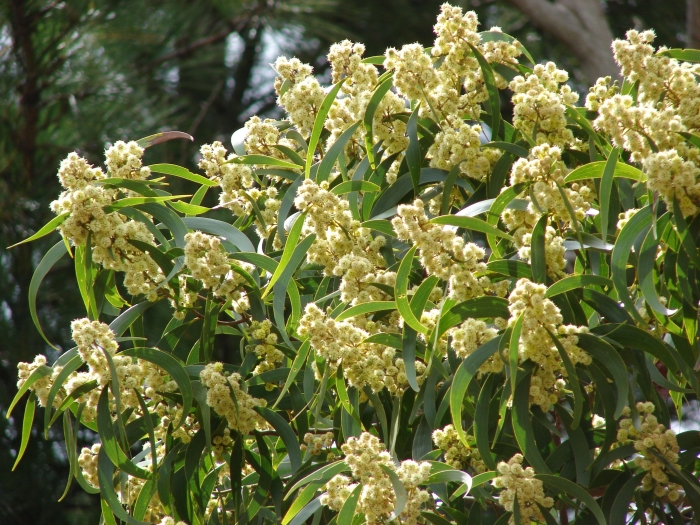Koa
(Acacia koa)
Koa (Acacia koa)
/
/

Photo by Forest & Kim Starr
CC BY 2.5
Image By:
Photo by Forest & Kim Starr
Recorded By:
Copyright:
CC BY 2.5
Copyright Notice:
Photo by: Photo by Forest & Kim Starr | License Type: CC BY 2.5 | License URL: https://creativecommons.org/licenses/by/2.5 | Uploader: Photohound | Publisher: Wikimedia Commons | Title: Starr_070205_4082_acacia_koa2.jpg | Notes: {{Information |Description={{en|1=Acacia myrtifolia}} |Source=Own work by uploader |Author=[[User:Casliber|Casliber]] |Date=2002 |Permission=yes |other_versions= }} {{ImageUpload|full}} |














































































Estimated Native Range
Summary
Acacia koa, commonly known as Koa, is an evergreen tree endemic to the Hawaiian Islands, where it thrives in a variety of ecosystems including montane forests, cloud forests, and volcanic slopes. Koa trees are significant components of the native forest ecology, providing habitat for numerous endemic species. They typically reach a height of 15–25 meters (49–82 feet) and a spread of 6–12 meters (20–39 feet), with a rapid growth rate that makes them one of the fastest-growing Hawaiian trees. The tree’s appearance is characterized by a spreading canopy and sickle-shaped phyllodes (modified leaf stems that function as leaves) instead of true leaves. The pale-yellow flowers are small, yet numerous, arranged in spherical racemes about 8–10 mm (0.31–0.39 inches) in diameter. Depending on the elevation and local conditions, flowering may occur seasonally or year-round.
Koa wood is highly valued for its rich color and grain, making it popular for fine woodworking and traditional Hawaiian crafts. The tree is also used for reforestation and habitat restoration projects. In cultivation, Koa is appreciated for its rapid growth and nitrogen-fixing abilities, which can improve soil fertility. It is best grown in full sun and requires medium amounts of water. Koa prefers acidic to neutral soils (pH of 4–7.4), particularly Inceptisols derived from volcanic ash or well-drained histosols. While generally disease-resistant, Koa can be susceptible to koa wilt caused by the fungus Fusarium oxysporum. Gardeners should be aware that Koa trees have large root systems that can disrupt nearby structures if planted too close.CC BY-SA 4.0
Koa wood is highly valued for its rich color and grain, making it popular for fine woodworking and traditional Hawaiian crafts. The tree is also used for reforestation and habitat restoration projects. In cultivation, Koa is appreciated for its rapid growth and nitrogen-fixing abilities, which can improve soil fertility. It is best grown in full sun and requires medium amounts of water. Koa prefers acidic to neutral soils (pH of 4–7.4), particularly Inceptisols derived from volcanic ash or well-drained histosols. While generally disease-resistant, Koa can be susceptible to koa wilt caused by the fungus Fusarium oxysporum. Gardeners should be aware that Koa trees have large root systems that can disrupt nearby structures if planted too close.CC BY-SA 4.0
Plant Description
- Plant Type: Tree
- Height: 50-80 feet
- Width: 20-40 feet
- Growth Rate: Moderate
- Flower Color: Yellow
- Flowering Season: Spring
- Leaf Retention: Evergreen
Growth Requirements
- Sun: Full Sun
- Water: Medium
- Drainage: Fast, Medium
Common Uses
Bee Garden, Bird Garden, Butterfly Garden, Drought Tolerant, Erosion Control, Hummingbird Garden, Showy Flowers
Natural Habitat
Montane forests, cloud forests, and volcanic slopes
Other Names
Common Names: Koa Acacia
Scientific Names: , Acacia koa, Acacia heterophylla var. latifolia, Acacia koa var. koa, Acacia koa var. hawaiiensis, Acacia heterophylla, Acacia koa var. latifolia, Acacia koa var. weimeae, Acacia coa, Acacia koa var. lanoiensis
GBIF Accepted Name: Acacia koa A.Gray